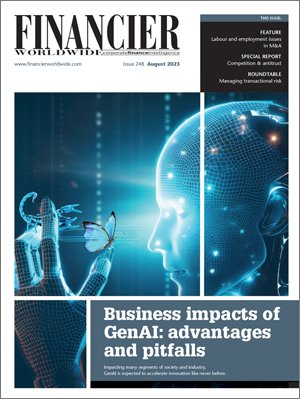Huge and growing: the rise of NAV financing
August 2023 | FEATURE | PRIVATE EQUITY
Financier Worldwide Magazine
Although net asset value (NAV) financing has been a feature of the market for some time (with funds of hedge funds (FoHFs) using it for more than two decades), it has come a long way in just a few years.
Indeed, the past 12 to 18 months has seen an all-time high in NAV financing activity within the private equity (PE) industry, both in the US and across Europe, continuing the acceleration of market development that began during the coronavirus (COVID-19) pandemic.
According to 17Capital, 2022 was a record year for NAV financing activity across the PE industry, with 50 percent growth in deal volume for the 12-month period ending September 2022. There was a 40 percent increase in the average transaction size during the same period. These figures indicate the widespread adoption of NAV financing by some of the largest general managers and their larger underlying portfolios.
NAV financing essentially allows PE firms to raise borrowings against the NAV of the assets in their funds. PE managers are using it, often as an alternative to mezzanine funding or additional equity investment, to create value in their funds through add-on acquisitions for existing portfolio companies. They are embracing NAV financing as a valuable, flexible tool to enhance growth.
“Although many NAV lenders and borrowers are reportedly grappling with how to price the underlying assets in a NAV facility amid current market conditions, this problem has not stalled momentum.”
Recently, more PE funds have been driven to explore NAV financing due to the significant contraction in the supply of other traditional liquidity resources, including fundraising and subscription lines of credit. During Q1 2023, the demand for NAV facilities grew even faster as a result of the tough PE exit environment and the lack of traditional financing sources amid bouts of volatility.
In the US, PE-backed exit activity has been particularly lethargic, with exit value totalling $55.8bn in Q1 2023 – a 14.5 percent decline from the previous quarter, according to PitchBook. At the same time, the median enterprise value for companies being acquired in US and European PE buyouts in the first three months of this year stood at 1.7x revenue, down from 2.4x in 2022.
The recent explosion in NAV financing usage is largely driven by the growing focus on liquidity in the PE space in the current market environment, as firms seek to manage their own liquidity needs. As NAV financing proved during the height of the pandemic, it is a valuable portfolio management tool which will stand firms in good stead as microeconomic pressures continue to be felt in the months ahead.
Indeed, some PE firms are reluctant to sell assets at a time when valuations have come down substantially. NAV financing allows them to support their portfolio companies and extend holding periods through a more volatile economy.
According to eFront, the alternative assets software group owned by BlackRock, average holding periods in PE climbed from 3.8 years in 2010 to 5.4 years in 2020. The study also found that longer hold periods predict higher returns. On average, multiples on invested capital (gross of fees) came in at less than 2x for portfolio companies held for less than two years, but improved to around 2.5x after a five-year hold, and around 2.6x for deals held for between nine and 10 years.
Fund managers are also using NAV proceeds to refinance soon-to-mature credit facilities borrowed by portfolio companies, which reduces borrowing costs for these companies, as debt financing for highly leveraged issuers has become more expensive in the current market.
NAV financing is also advantageous for investors. According to Deloitte, the average loan-to-value ratios for NAV facilities sit in the 25 to 30 percent range, so when used for limited partner distributions pre-exit, investors can receive a significant slice of value earlier in a hold period, which in turn enhances their internal rates of return.
The sheer size of the PE market suggests continued NAV financing growth is likely. According to Preqin, private equity funds had around $8.3 trillion of assets under management (AUM) at the end of 2021 and unrealised NAV of $1.6 trillion across European and North American PE firms. Extrapolating those numbers out, 17Capital has projected that the NAV financing market, which currently sits at around $100bn, could triple in size by 2025 and reach $700bn by 2030.
Although many NAV lenders and borrowers are reportedly grappling with how to price the underlying assets in a NAV facility amid current market conditions, this problem has not stalled momentum. As the NAV financing space continues to grow and develop, NAV facilities and hybrid facilities (which combine subscription facilities and NAV facilities into one agreement) will continue to prosper.
© Financier Worldwide
BY
Richard Summerfield


